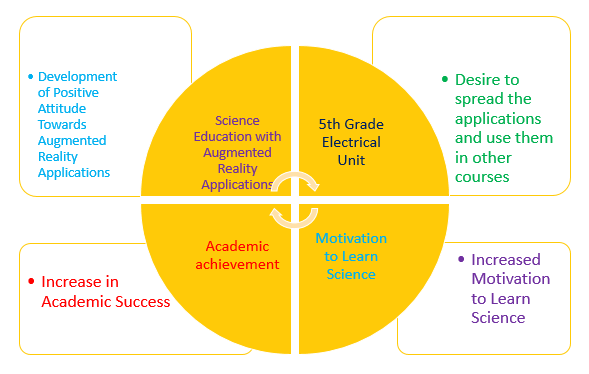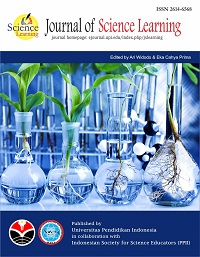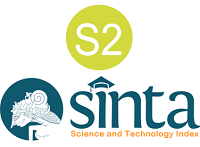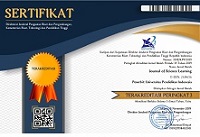
Augmented Reality in 5th Grade Electricity Unit: Effects on Achievement, Motivation and Attitude
Abstract
This study aims to examine the effects of augmented reality (AR) in science courses. The study was conducted with 55 fifth grade students and a mixed method approach was adopted. An exploratory sequential design, a specific type of mixed-method design, was implemented in the research. In addition to various scales measuring academic achievement, motivation and attitudes towards science lessons, semi-structured interview forms were also used to understand students' perceptions of AR experiences. As a result of the study, no significant difference was found in terms of academic achievement between the experimental group, which was taught with AR supported science lessons, and the control group, which was taught with the traditional method. However, it was observed that the students who used AR had more positive attitudes towards science lessons and their motivation towards the lesson increased significantly. This shows that AR increases students' interest in science learning and enables them to participate more actively in the learning process. In conclusion, although augmented reality is not directly effective on academic achievement, it contributes positively to student motivation and attitude by enriching the learning environment.
Keywords
Full Text:
Download PDFReferences
Abdusselam, M. S. (2014). Teachers' and students' views on using augmented reality environments in physics education: 11th grade magnetism topic example. Pegem Journal of Education & Instruction / Pegem Egitim ve Ögretim, 4(1).
Akçayır, M., Akçayır, G., Pektaş, H. M., & Ocak, M. A. (2016). Augmented reality in science laboratories: The effects of augmented reality on university students’ laboratory skills and attitudes toward science laboratories. Computers in Human Behavior, 57, 334–342.
Akkoyunlu, B. (1995). The use of information technologies in schools and the role of teachers. Hacettepe University Journal of Faculty of Education, 11(11).
Akkuş, A. (2021). The effect of augmented reality applications in mobile devices in mathematics education on the academic success and motivation of secondary school 8th grade students [Unpublished master’s thesis]. Van Yüzüncü Yıl University.
Al-Ansi, A. M., Jaboob, M., Garad, A., & Al-Ansi, A. (2023). Analyzing augmented reality (AR) and virtual reality (VR) recent development in education. Social Sciences & Humanities Open, 8(1), 100532.
Bacca, J., Baldiris, S., Fabregat, R., & Graf, S. (2015). Mobile augmented reality in vocational education and training. Procedia Computer Science, 75, 49–58.
Bilgiç, H. G., Duman, D., & Seferoğlu, S. S. (2011). The characteristics of digital natives and their effects on the design of online environments. Academic Informatics, 2(4), 1–7.
Billinghurst, M., Kato, H., & Poupyrev, I. (2001). The MagicBook: A transitional AR interface. Computers & Graphics, 25(5), 745–753.
Bujak, K. R., Radu, I., Catrambone, R., MacIntyre, B., Zheng, R., & Golubski, G. (2013). A psychological perspective on augmented reality in the mathematics classroom. Computers & Education, 68, 536–544.
Büyüköztürk, Ş., Akgün, Ö. E., Demirel, F., Karadeniz, Ş., & Çakmak, E. K. (2015). Scientific research methods (4th ed.).
Cai, S., Chiang, F. K., Sun, Y., Lin, C., & Lee, J. J. (2017). Applications of augmented reality-based natural interactive learning in magnetic field instruction. Interactive Learning Environments, 25(6), 778–791.
Cai, S., Niu, X., Wen, Y., & Li, J. (2021). Interaction analysis of teachers and students in inquiry class learning based on augmented reality by IFIAS and LSA. Interactive Learning Environments, 1–17.
Carrascosa, C. L., Ylardia, I. P., Paredes-Velasco, M., & García-Suelto, M. D. C. N. (2024). Game-based learning with augmented reality for history education. IEEE Revista Iberoamericana de Tecnologias del Aprendizaje.
Chen, C. P., & Wang, C. H. (2015). Employing augmented-reality-embedded instruction to disperse the imparities of individual differences in earth science learning. Journal of Science Education and Technology, 24, 835–847.
Chiang, T. H. C., Yang, S. J. H., & Hwang, G.-J. (2014). An augmented reality-based mobile learning system to improve students’ learning achievements and motivations in natural science inquiry activities. Educational Technology & Society, 17(4), 352–365.
Creswell, J. W., & Clark, V. L. P. (2017). Designing and conducting mixed methods research. Sage Publications.
Çepni, S. (2010). Introduction to research and project studies. Trabzon.
Çetintav, G. (2023). The effect of using augmented reality applications in geometry teaching on middle school students' self-regulation skills, academic motivation and achievement (Master's thesis, Bartın University, Graduate School of Natural and Applied Sciences).
Çınar, D. (2017). The effect of augmented reality supported textbook on students' achievement and attitudes in English language teaching (Master's thesis, Institute of Educational Sciences).
Dede, Y., & Yaman, S. (2008). Motivation scale for learning science: Validity and reliability study. Necatibey Education Faculty Electronic Journal of Science and Mathematics Education, 2(1), 19–37.
Durak, A., & Yılmaz, F. G. K. (2019). Middle school students' views on the educational applications of augmented reality. Abant İzzet Baysal University Journal of Education, 19(2), 468–481.
Durmuş, S. (2017). The effect of education expenditures on economic growth: An empirical study. Finance Political & Economic Reviews, 54(629), 9–18.
Eren, A. A. (2019). The effect of using augmented reality applications in teaching elements and compounds on students' academic achievement and permanence of the knowledge they learn (Master’s thesis). Erciyes University Institute of Educational Sciences, Kayseri.
Fidan, M., & Tuncel, M. (2019). Integrating augmented reality into problem-based learning: The effects on learning achievement and attitude in physics education. Computers & Education, 142, 103635.
Fleck, S., & Simon, G. (2013, November). An augmented reality environment for astronomy learning in elementary grades: An exploratory study. In Proceedings of the 25th Conference on l'Interaction Homme-Machine (pp. 14–22).
Furió, D., Juan, M.-C., Segui, I., & Vivó, R. (2015). Mobile learning vs. traditional classroom lessons: A comparative study. Journal of Computer Assisted Learning, 31(3), 189–201.
Gültekin, M., Bayır, Ö., & Yaşar, E. (2020). Mixed research methods. In B. Oral & A. Çoban (Eds.), Scientific research methods in education from theory to practice (pp. 317–354).
Gümbür, Y. (2019). The effect of using augmented reality application in social studies on students’ academic achievement, attitude and motivation (Master’s thesis). Muğla Sıtkı Koçman University.
İbili, E., Çat, M., Resnyansky, D., Şahin, S., & Billinghurst, M. (2020). An assessment of geometry teaching supported with augmented reality teaching materials to enhance students' 3D geometry thinking skills. International Journal of Mathematical Education in Science and Technology, 51(2), 224–246. https://doi.org/10.1080/0020739X.2019.1583382
İbili, E., & Şahin, S. (2013). Design and development of interactive 3D geometry book software with augmented reality: ARGE3D. Afyon Kocatepe University Journal of Science and Engineering Sciences, 13(1), 1–8.
İzgi Onbaşılı, Ü. (2018). The effect of augmented reality applications on primary school students' attitudes towards augmented reality applications and science motivation. Ege Journal of Education, 19(1), 320–337.
Johnson, L., Levine, A., Smith, R., & Stone, S. (2010). The 2010 Horizon Report. New Media Consortium.
Karakaş, M., & Özerbaş, M. (2020). The effect of augmented reality applications on students' academic achievement in physics course. Educational Technology Theory and Practice, 10(2), 452–468.
Kardoğan, S. (2022). Investigation of the possible contributions of equine front leg bone models prepared using augmented reality to the learning activity of veterinary anatomy undergraduate students (Master's thesis). Adnan Menderes University Institute of Health Sciences.
Kavak, İ. (2021). Designing an augmented reality and simulation supported learning environment for electronic circuit elements course (Master's thesis). Bursa Uludağ University.
Khan, T., Johnston, K., & Ophoff, J. (2019). The impact of an augmented reality application on learning motivation of students. Advances in Human-Computer Interaction, 2019, 7208494.
Kırıkkaya, E. B., & Şentürk, M. (2018). The effect of using augmented reality technology on student academic achievement in Solar System and Beyond unit. Kastamonu Journal of Education, 26(1), 181–189.
Koçak, Ö., Yılmaz, R. M., Küçük, S., & Göktaş, Y. (2019). The educational potential of augmented reality technology: Experiences of instructional designers and practitioners. Journal of Education and Future, (15), 17–36.
Küçük, S., Yılmaz, R., Baydaş, Ö., & Göktaş, Y. (2014). Augmented reality applications attitude scale in secondary schools: Validity and reliability study. Education and Science, 39(176).
Lampropoulos, G. (2024). Virtual reality and gamification in education: A systematic review. Educational Technology Research and Development, 1–95.
Mahadzir, N. N., & Phung, L. F. (2013). The use of augmented reality pop-up book to increase motivation in English language learning for national primary school. Journal of Research & Method in Education, 1(1), 26–38.
Moser, S., & Lewalter, D. (2024). The impact of instructional support via generative learning strategies on the perception of visual authenticity, learning outcomes, and satisfaction in AR-based learning. European Journal of Psychology of Education, 1–26.
Neri, I., Cercenelli, L., Marcuccio, M., Lodi, S., Koufi, F. D., Fazio, A., & Ratti, S. (2024). Dissecting human anatomy learning process through anatomical education with augmented reality: AEducAR 2.0, an updated interdisciplinary study. Anatomical Sciences Education, 17(4), 693–711.
Oh, S., & Woo, W. (2008). AR Garden: Augmented edutainment system with a learning companion. Transactions on Edutainment Lecture Notes in Computer Science, 5080, 40–50.
Özaltın, G., & Kahraman, M. E. (2023). The contribution of augmented reality (AR) technology to interactive learning in design education. Art-e Art Journal, 16(32), 110–141.
Özdemir, M. (2017). Experimental studies on learning with augmented reality technology: A systematic review. Mersin University Journal of Faculty of Education, 13(2), 609–632.
Özmen, H. (2004). Learning theories in science education and technology-supported constructivist learning. The Turkish Online Journal of Educational Technology, 3(1), 100–111.
Pan, X., Zheng, M., Xu, X., & Campbell, A. G. (2021). Knowing your student: Targeted teaching decision support through asymmetric mixed reality collaborative learning. IEEE Access, 9, 164742–164751.
Patton, M. Q. (2005). Qualitative research. New York: John Wiley & Sons, Ltd.
Perez-Lopez, D., & Contero, M. (2013). Delivering educational multimedia contents through an augmented reality application: A case study on its impact on knowledge acquisition and retention. Turkish Online Journal of Educational Technology - TOJET, 12(4), 19–28.
Ramazanoğlu, M., & Solak, M. Ş. (2020). Secondary school students' attitudes towards the use of augmented reality applications in education: The case of Siirt province. Kastamonu Journal of Education, 28(4), 1646–1656.
Rizki, I. A., Saphira, H. V., Alfarizy, Y., Saputri, A. D., Ramadani, R., & Suprapto, N. (2023). Adventuring physics: Integration of adventure game and augmented reality based on Android in physics learning. International Journal of Interactive Mobile Technologies, 17(1).
Sayımer, İ., & Küçüksaraç, B. (2015). The contribution of new technologies to university education: Communication faculty students' views on augmented reality applications. International Journal of Human Sciences, 12(2), 1536–1554.
Sırakaya, M. (2015). The effect of augmented reality applications on students' academic achievement, misconceptions and participation in the course (Unpublished doctoral thesis). Gazi University, Institute of Educational Sciences, Ankara.
Sinan, D., & Yener, A. (2023). Modelling teachers' use of information technologies during the COVID-19 pandemic by the technology acceptance model. International Journal of Contemporary Economics and Administrative Sciences, 13(1), 127–147. https://doi.org/10.5281/zenodo.8332508
Singhal, S., Bagga, S., Goyal, P., & Saxena, V. (2012). Augmented chemistry: Interactive education system. International Journal of Computer Applications, 49(15), 1–5.
Solak, E., & Cakir, R. (2015). Exploring the effect of materials designed with augmented reality on language learners' vocabulary learning. Journal of Educators Online, 12(2), 50–72.
Tanrıverdi, B. (2022). The effect of reading books supported by augmented reality technology on language development of preschool children (Case study) (Unpublished Master's project). Pamukkale University, Institute of Educational Sciences, Denizli. https://hdl.handle.net/11499/39001
Tiwari, A. S., Bhagat, K. K., & Lampropoulos, G. (2024). Designing and evaluating an augmented reality system for an engineering drawing course. Smart Learning Environments, 11(1), 1.
Vate-U-Lan, P. (2012, July). An augmented reality 3D pop-up book: The development of a multimedia project for English language teaching. In 2012 IEEE International Conference on Multimedia and Expo (pp. 890–895). IEEE.
Vilkoniene, M. (2009). Influence of augmented reality technology upon pupils' knowledge about human digestive system: The results of the experiment. Online Submission, 6(1), 36–43.
Wei, L. S., & Elias, H. (2011). Relationship between students' perceptions of classroom environment and their motivation in learning English language. International Journal of Humanities and Social Science, 21.
Wojciechowski, R., & Cellary, W. (2013). Evaluation of learners' attitude towards learning in ARIES augmented reality environments. Computers & Education, 68, 570–585.
Wu, H. K., Lee, S. W. Y., Chang, H. Y., & Liang, J. C. (2013). Current status, opportunities and challenges of augmented reality in education. Computers & Education, 62, 41–49.
Yıldırım, A., & Şimşek, H. (2013). Qualitative research methods in social sciences (9th ed.). Ankara: Seçkin Publishing.
Yılmaz, Z. A., & Batdı, V. (2016). Meta-analytic and thematic comparative analysis of the integration of augmented reality applications with education. Education and Science, 41(188).
Zhang, J., Sung, Y. T., Hou, H. T., & Chang, K. E. (2014). The development and evaluation of an augmented reality-based armillary sphere for astronomical observation instruction. Computers & Education, 73, 178–188.
Zhou, Z., Cheok, A. D., & Pan, J. (2004). 3D StoryCube: An interactive tangible user interface for storytelling with 3D graphics and audio. Personal and Ubiquitous Computing, 8, 374–376.
DOI: https://doi.org/10.17509/jsl.v8i2.82111
Refbacks
- There are currently no refbacks.
Copyright (c) 2025 Hasan Hüseyin KUL, Asiye BERBER

This work is licensed under a Creative Commons Attribution-ShareAlike 4.0 International License.


Jl. Dr. Setiabudhi 229 Bandung 40154, West Java, Indonesia










